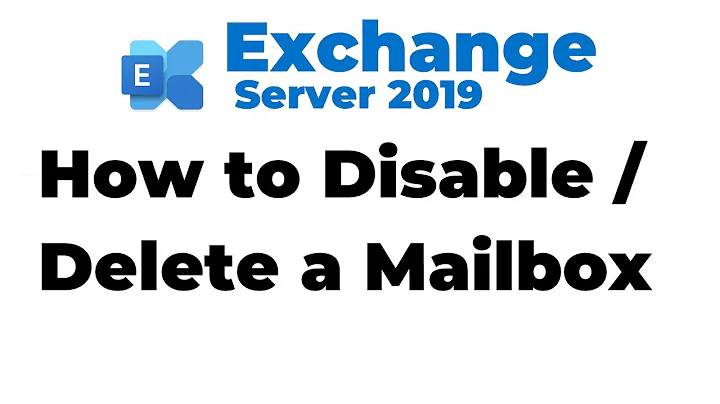How to remove the SMTP address for a secondary domain from all Exchange mailboxes?
Solution 1
Here is a better version than my original answer (it handles multiple addresses to remove for each mailbox and also gives more output):
$domain = 'somedomain.com'
$mbxs = Get-Mailbox -ResultSize Unlimited
foreach($m in $mbxs)
{
Write-Host 'Mailbox:' $m.SAMAccountName
$addrs = $m.EmailAddresses
for($i = 0;$i -lt $addrs.Count;$i++)
{
$addr = $addrs[$i]
if($addr.PrefixString -eq 'smtp'-and $addr.SmtpAddress -like '*@' + $domain)
{
Write-Host 'Removing address:' $addr.SmtpAddress
$m.EmailAddresses.RemoveAt($i)
$i--
}
}
if($addrs.Changed)
{
Write-Host 'Saving mailbox:' $m.SAMAccountName
Set-Mailbox $m -EmailAddresses $addrs
}
else
{
Write-Host 'No address to remove'
}
}
Solution 2
Test this in a lab and/or on a small set of test users before hitting production with this please.
$SMTPDomainToRemove = "@OldDomain.com"
$AllUsers = Get-ADUser -Filter * -Properties proxyAddresses
Foreach($usr In $AllUsers)
{
$NewAddressList = @()
$OldAddressList = $usr.proxyAddresses
Foreach($addr In $OldAddressList)
{
If(!($addr -Match $SMTPDomainToRemove))
{
$NewAddressList += $addr
}
}
If($NewAddressList.Count -GT 0)
{
Set-ADUser $usr -Replace @{ 'proxyAddresses' = $NewAddressList}
}
}
The idea is that we're taking the proxyAddresses address list of each user, stripping out the ones that have the old domain name in them, and then replacing the address list with the new, updated one that does not contain references to the old domain name.
http://blogs.technet.com/b/exchange/archive/2005/01/10/350132.aspx
E-Mail Address Attributes
Exchange stores and uses information about the e-mail addresses of a recipient in the following attributes: proxyAddresses
This is the main attribute where e-mail address information is kept. When you open the properties of a recipient in Outlook and look at the "E-mail Addresses" tab, you are looking at this attribute. This is a multi-valued string containing all the addresses that represent the recipient. Each value must have the following format: type:address
For example: SMTP:[email protected]
When the type is in uppercase letters, the address is considered to be the primary address of that type and it is used as the default reply address of that recipient. When the type is in lowercase letters, the address is considered a secondary address and is used to resolve addresses during e-mail delivery, allowing the same recipient to receive e-mails directed to different e-mail addresses.
Related videos on Youtube
Massimo
"Against stupidity, the Gods themselves fight in vain." https://www.linkedin.com/in/massimo-pascucci
Updated on September 18, 2022Comments
-
 Massimo over 1 year
Massimo over 1 yearI have an Exchange server which used to manage multiple SMTP domains; now it only has to manage one.
I have already removed the secondary domain from all address policies; I need to remove all SMTP addresses referencing it.
All users have their primary SMTP address set to use the primary domain; but almost all of them have another address using the secondary domain. They also have many other different addesses: the SIP one used for lync, and one or more X500 ones derived from previous migrations. These should not be touched at all.
How can I remove all those secondary SMTP addresses without affecting anything else?
-
 joeqwerty over 10 yearsADModify.NET - admodify.codeplex.com
joeqwerty over 10 yearsADModify.NET - admodify.codeplex.com -
kralyk over 10 years+1 for ADModify.NET. It will do this easily...and can even make sure the "primary SMTP address/reply to" is set if necessary.
-
-
 Mathias R. Jessen over 10 yearsWell, my primary address is
Mathias R. Jessen over 10 yearsWell, my primary address is[email protected]and now I don't have to mind my inbox anymore, thanks! :D -
 Ryan Ries over 10 yearsOK... How about
Ryan Ries over 10 yearsOK... How about$addr.ToLower().Trim().EndsWith($SMTPDomainToRemove.ToLower().Trim())... better? :) -
 Ryan Ries over 10 yearsOr even just a well-placed @ sign... ;)
Ryan Ries over 10 yearsOr even just a well-placed @ sign... ;)




